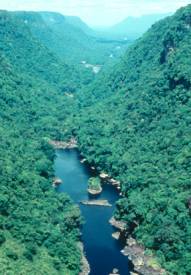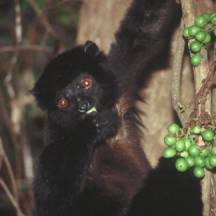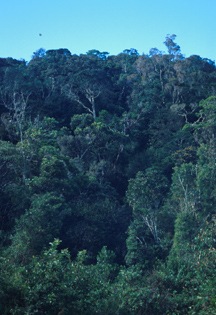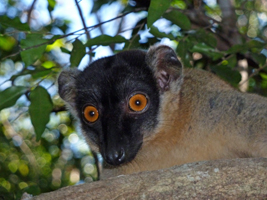
My research is supported by the Natural
Sciences and Engineering Research Council of Canada
and University
of Toronto. Much of my current research focuses on the
conservation biogeography and landscape ecology of South
American and Madagascar primates (click on the TREE tab to
learn more). Conservation biogeography is the application of
biogeographical principles, theories, and analyses, being
those concerned with the distributional dynamics of taxa
individually and collectively, to problems concerning the
conservation of biodiversity (Whittaker et al., 2005). In my
research, I seek to determine how specific present-day and
historic factors affect the distribution and diversity of
primates. Towards this end, I have conducted research on
primates in Venezuela, Guyana, Suriname, and Madagascar. For
example, I conducted one of the first studies of primate
biogeography in Guyana. Guyana is unique in that it retains
approximately 75% of its original forest cover. Moreover,
Guyana is one of the last places in South America where you
can regularly see big cats, such as jaguars and ocelots;
giant river otters; and manatees. I used surveys, geographic
information systems, and remote sensing to document the
varied distribution and diversity of eight primate species
in Guyana. I found that the biogeography of each species is
due to a complicated pattern of present-day (e.g., habitat
diversity and the distribution of important food resources)
and historic factors (e.g., riverine barriers to dispersal).
 In 1998, I began a research program on the
conservation biology of lemurs in the forests of Madagascar,
an island famous for its endemic plants and animals. The
first phase of my program was a study of the critically
endangered Perrier's sifakas (Propithecus perrieri).
Only 500-1000 of these lemurs exist in the wild. My research
team and I were among the first researchers ever to locate,
habituate, and collect detailed behavioral and ecological
data on Perrier's sifakas (see picture to left of male
Perrier's sifaka eating ficus fruit).
In 1998, I began a research program on the
conservation biology of lemurs in the forests of Madagascar,
an island famous for its endemic plants and animals. The
first phase of my program was a study of the critically
endangered Perrier's sifakas (Propithecus perrieri).
Only 500-1000 of these lemurs exist in the wild. My research
team and I were among the first researchers ever to locate,
habituate, and collect detailed behavioral and ecological
data on Perrier's sifakas (see picture to left of male
Perrier's sifaka eating ficus fruit).
 The 2nd phase of my research program was to
conduct a series of RAPs (Rapid Assessment Projects) in some
of the last unexplored jungle in eastern Madagascar. This
research focused primarily on the Fandriana-Marolambo forest
corridor. We worked very closely with a local NGO called
MICET (Malagasy Institute for the Conservation of Tropical
Environments) on all projects in the corridor. The data were
collected by a team of mammologists, botanists,
herpetologists, and ornithologists with the goal of setting
up a new protected area in eastern Madagascar. I am pleased
to report that our RAP data have been used, in part, to
create Marolambo National Park.
The 2nd phase of my research program was to
conduct a series of RAPs (Rapid Assessment Projects) in some
of the last unexplored jungle in eastern Madagascar. This
research focused primarily on the Fandriana-Marolambo forest
corridor. We worked very closely with a local NGO called
MICET (Malagasy Institute for the Conservation of Tropical
Environments) on all projects in the corridor. The data were
collected by a team of mammologists, botanists,
herpetologists, and ornithologists with the goal of setting
up a new protected area in eastern Madagascar. I am pleased
to report that our RAP data have been used, in part, to
create Marolambo National Park.
 In the 3rd phase of my research program, the
TREE team and I are looking at how forest loss, forest
fragmentation, and edge effects influence lemur ecology in
Madagascar. The long-term objectives of this research
program are to study the independent effects of forest loss
and fragmentation on primates at the landscape scale in
Madagascar and to provide Canadian and international
students with research and training opportunities in
tropical ecology. Current research projects are focused on
the conservation biogeography of plant and primate
communities at the new Ambanjabe Forest Fragment Project
(AFFP), located in the western region of Ankarafantsika National Park, NW
Madagascar. The AFFP is a multidisciplinary
investigation of mammal diversity and abundance, lemur
population genetics, and community conservation in a
fragmented landscape of 42 forest fragments. We have also
been conducting complementary research in the Maririano
region along the coast of NW Madagascar.
In the 3rd phase of my research program, the
TREE team and I are looking at how forest loss, forest
fragmentation, and edge effects influence lemur ecology in
Madagascar. The long-term objectives of this research
program are to study the independent effects of forest loss
and fragmentation on primates at the landscape scale in
Madagascar and to provide Canadian and international
students with research and training opportunities in
tropical ecology. Current research projects are focused on
the conservation biogeography of plant and primate
communities at the new Ambanjabe Forest Fragment Project
(AFFP), located in the western region of Ankarafantsika National Park, NW
Madagascar. The AFFP is a multidisciplinary
investigation of mammal diversity and abundance, lemur
population genetics, and community conservation in a
fragmented landscape of 42 forest fragments. We have also
been conducting complementary research in the Maririano
region along the coast of NW Madagascar.
© 2023 Shawn M. Lehman
